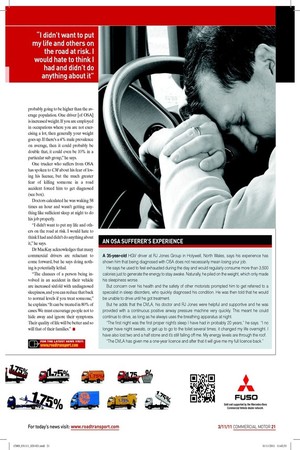Nightmare
Page 15

Page 16

If you've noticed an error in this article please click here to report it so we can fix it.
on the road
One in 10 of all lorry drivers could suffer from a dangerous sleeping condition and may not even know about it
Words: Chris Tindall
THOUSANDS OF HGV drivers could be affected by a potentially lethal sleep disorder that increases the chances of a road trafic accident sixfold, but many are unaware they are sufferers, according to a medical expert.
Dr Tom MacKay, a consultant respiratory physician at the Sleep Centre in Edinburgh, says obstructive sleep apnoea (OSA) could affect 10% of lorry drivers and yet treatment is simple, quick and effective.
OSA causes disturbed sleep patterns in which a person wakes up many times a night without realising it.
It means sufferers do not get sufi cient sleep and therefore increases the chances of them dozing off behind the wheel.
In one tragic case last year an HGV driver with OSA fell asleep near the Dartford tunnel and crashed into a car, killing one of the occupants and leaving the other with serious brain damage.
As a result an e-petition has been created by the mother of one of the victims to encourage haulage companies to raise awareness among their drivers and prevent more accidents.
The Department for Transport says fatigue was recorded as a contributory factor in 1,766 road accidents in 2010, a 2.5% reduction since 2008.
However, the number of people being diagnosed with OSA is rising and Dr MacKay thinks it could be just the tip of the iceberg.
“There has been a 25% rise in referrals from GPs in Scotland over the last three years,” he says. “We have fairly consistent igures; 4% of the male population and 2% of females aged between 35 and 65 [are sufferers]. If you take Scotland as an example and multiply those numbers, then that’s probably 50,000 people. We have probably identiied and treated about 15,000, so we are probably a third of the way there.” However, Dr MacKay also says that some professions could harbour a far higher proportion of people with OSA, due to the nature of the job.
“If you take people in largely sedentary jobs, long-distance lorry drivers for example, the percentage of those is probably going to be higher than the average population. One driver [of OSA] is increased weight. If you are employed in occupations where you are not exercising a lot, then generally your weight goes up. If there’s a 4% male prevalence on average, then it could probably be double that, it could even be 10% in a particular sub group,” he says.
One trucker who suffers from OSA has spoken to CM about his fear of losing his licence, but the much greater fear of killing someone in a road accident forced him to get diagnosed (see box).
Doctors calculated he was waking 58 times an hour and wasn’t getting anything like suficient sleep at night to do his job properly.
“I didn’t want to put my life and others on the road at risk. I would hate to think I had and didn’t do anything about it,” he says.
Dr MacKay acknowledges that many commercial drivers are reluctant to come forward, but he says doing nothing is potentially lethal.
“The chances of a person being involved in an accident in their vehicle are increased sixfold with undiagnosed sleepiness, and you can reduce that back to normal levels if you treat someone,” he explains. “It can be treated in 80% of cases. We must encourage people not to hide away and ignore their symptoms. Their quality of life will be better and so will that of their families.” ■













































